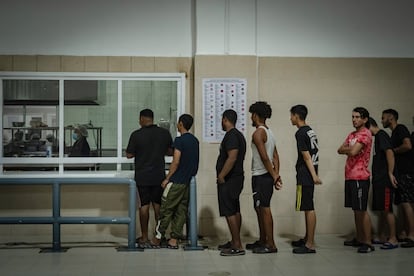More care centers and safe transfers to the US border: Mexico outlines its migration strategy for the coming years
Foreign Secretary Alicia Bárcena says her plan, which has reduced irregular crossings into the US by 66%, will continue during Sheinbaum’s six-year term

In 27 days, Alicia Bárcena will stop being President Andrés Manuel López Obrador’s foreign secretary to become Claudia Sheinbaum’s environment minister. But before leaving, the official is trying to outline Mexico’s migration strategy for the coming years. The plan, which she has called the “Mexican Model of Human Mobility,” includes investing $133 million in countries of origin, creating two new care centers in Chiapas, and the safe transfer to the northern border of migrants with an asylum appointment in the United States. The foreign minister said on Wednesday that her model, which has reduced irregular crossings into the neighboring country by 66%, is not going to go away when she leaves her position: “I presented it to President-elect Claudia Sheinbaum, who was very interested, so I am sure that this strategy will continue.”
Mexico is trapped between migration figures. In the north, Joe Biden’s administration has agreed to manage 4,000 crossings a day, 1,500 through its CBP One platform. But no more, says Bárcena, who remembers December 18, 2023, when the United States announced the closure of seven of its border posts. “Why? Because 12,500 people had arrived at the northern border.” Meanwhile, in the south, 712,000 migrants have entered Mexico in the first six months of 2024 alone. In this bottleneck are the overcrowded camps from Tapachula to Ciudad Juárez, the violence, corruption and the massacres.
The foreign minister’s focus is on creating safe routes for migrants upon entering Mexico. “We have managed some very concrete achievements,” said Bárcena, who took over 15 months ago from Marcelo Ebrard. For those who want to go to the United States, the Ministry of Foreign Affairs has negotiated with the Biden administration that an appointment for CBP One can be requested from anywhere in the country. Previously, the platform could only be accessed from the 19th parallel, which runs through Mexico City, or further north. Since August 23, it also operates from Chiapas or Tabasco, where migrant processing is concentrated.
Along those lines, Bárcena’s latest measure is that once the migrants have a confirmed appointment with CBP One, the Mexican authorities will be the ones to transport them: “We will take them to the border so that they do not have to go through the enormous risks of the journey. In some cases it will be Matamoros, in others, Tijuana, we already have clear routes, taking care of them, because we believe that guaranteeing safe mobility is part of our job.” This implies an immense change in the destinations of thousands of migrants, who identify the journey through Mexico as the most dangerous part of the entire journey to the north.
“Much of the solution to the northern border is on the southern border, investing in the south is the strategy,” she said. Behind this objective, in addition to the investment in cooperation of 2.25 billion pesos to create jobs in Belize, Cuba, Colombia, El Salvador, Guatemala, Haiti and Honduras, is the construction of two comprehensive aid centers in Chiapas. This morning, the foreign minister signed agreements with the United Nations and the International Organization for Migration (IOM) for the management of resources directed to these spaces. UNHCR, through its donors, has provided $3.5 million for the Multi-Service Center in Tapachula while the Government of Mexico is providing an additional $9.3 million. In addition, the Ministry of Foreign Affairs has secured additional philanthropic funds of $2.6 million.
The first center is being built in Tapachula; it will have the capacity to serve 1,500 asylum seekers a day and will be managed by the Mexican Commission for Refugee Aid (Comar). “Most of the people who arrive in Tapachula are seeking international protection. More and more were arriving and Comar was on the verge of collapse,” Andrés Ramírez, general coordinator of the commission, acknowledged this morning. In 2023, 140,000 migrants requested asylum in Mexico, a historic number in the country. “It is impossible to process all of them,” said Alicia Bárcena: “Comar, the government had left you alone, but now the government is with you very strongly and so is the United Nations.” The second space will be in Huitxla, in an expanded DIF centre, and will be oriented to the employment of migrants not seeking refuge, as well as migrant families. Foreign Affairs and Interior, along with Comar and UNHCR, will inaugurate the Tapachula center in January 2025, while the IOM will begin operating the center in Huixtla this year.
“Mexico is a country of origin, transit, destination and return of migration,” said the foreign minister, who believes that the “unique migratory characteristics” required a new strategy. “Migration was seen as a problem between the United States and Mexico — in the US it is an electoral issue, no doubt — and the new narrative demands that we see it as a regional phenomenon,” she noted, “We did so with a very clear compass: humanize mobility. The migrant is a person seeking opportunities for a better life.”
Sign up for our weekly newsletter to get more English-language news coverage from EL PAÍS USA Edition
Tu suscripción se está usando en otro dispositivo
¿Quieres añadir otro usuario a tu suscripción?
Si continúas leyendo en este dispositivo, no se podrá leer en el otro.
FlechaTu suscripción se está usando en otro dispositivo y solo puedes acceder a EL PAÍS desde un dispositivo a la vez.
Si quieres compartir tu cuenta, cambia tu suscripción a la modalidad Premium, así podrás añadir otro usuario. Cada uno accederá con su propia cuenta de email, lo que os permitirá personalizar vuestra experiencia en EL PAÍS.
¿Tienes una suscripción de empresa? Accede aquí para contratar más cuentas.
En el caso de no saber quién está usando tu cuenta, te recomendamos cambiar tu contraseña aquí.
Si decides continuar compartiendo tu cuenta, este mensaje se mostrará en tu dispositivo y en el de la otra persona que está usando tu cuenta de forma indefinida, afectando a tu experiencia de lectura. Puedes consultar aquí los términos y condiciones de la suscripción digital.
More information
Archived In
Últimas noticias
Most viewed
- Sinaloa Cartel war is taking its toll on Los Chapitos
- Oona Chaplin: ‘I told James Cameron that I was living in a treehouse and starting a permaculture project with a friend’
- Reinhard Genzel, Nobel laureate in physics: ‘One-minute videos will never give you the truth’
- Why the price of coffee has skyrocketed: from Brazilian plantations to specialty coffee houses
- Silver prices are going crazy: This is what’s fueling the rally











































